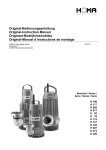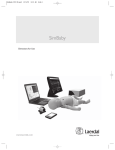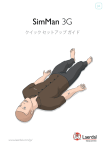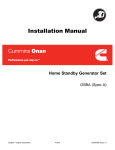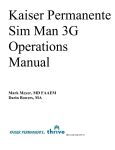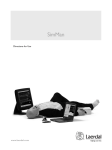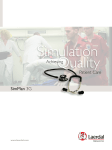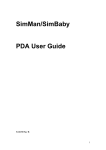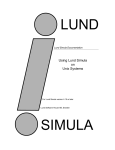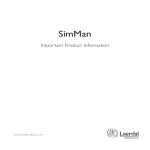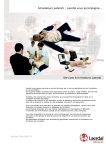Download simman tech service manual
Transcript
Copy Approved - Check Revision Before Use F00-0010 Rev A Attached is one native pdf file REV A DESCRIPTION OF CHANGE CHANGE REFERENCE Initial Release LN-06-101 ORIGINATOR VERIFIED APPROVED DATE AND SIGN DATE AND SIGN DATE AND SIGN DATE AND SIGN DATE AND SIGN DATE AND SIGN DATE AND SIGN Arne Hegland DATE AND SIGN Stein Birger Fodnestøl Digitally signed by Mauricio DATE AND SIGN La Borde Mauricio La Borde DN: CN = Mauricio La Borde, C = US, O = Laerdal Medical Corp., OU = Laerdal NY Date: 2006.03.21 13:38:51 05'00' Digitally signed by Arne Hegland DN: CN = Arne Hegland, C = NO, O = International Service Manager, OU = Technical Service Date: 2006.03.21 11:19:52 +01'00' Digitally signed by Stein Birger Fodnestøl DN: CN = Stein Birger Fodnestøl, C = NO, O = LMAS, OU = Product Management Reason: I am approving this document Date: 2006.03.28 08:57:41 +02'00' DMR THE INFORMATION CONTAINED HEREIN IS PROPRIETARY TO LAERDAL AND SHALL NOT BE USED FOR ANY PURPOSE DETRIMENTAL TO OR BE REPRODUCED WITHOUT PERMISSION OF LAERDAL REFERENCE REPLACES N/A PRODUCT GROUP 211 DHF REV N/A TOOL PART NO N/A 211-19550 TITLE REV A Technical Manual SimMan Mk.2 DOCUMENT NO PRO-PR02-0017 PAGE 1 of 3 ATTACH 1 REV A Copy Approved - Check Revision Before Use PRO-PR02-0017 Rev A Specification of Printed Matter Product Name: Part no.: Technical Manual SimMan Mk.2 211-19550 Revision 1. Functionality Description a. Technical Service Manual Function 2. Pre-press Description a. b. c. d. Ref. CD CD / DocuShare Proof print to Laerdal Ref. CD / DocuShare Drawing Document Pre-press file Correction File reference 3. Press a. b. c. d. e. f. Color Paper Paper Paper Paper Paper A Description type, jacket type insides Weight, jacket Weight insides Color 4+4 CMYK Plastic foil Silk 0,0116 mm 80 grams Ref. item 9 below 4. Label Description a. b. c. d. e. f. NA NA NA NA NA NA Cutting of label Type of clue Size Type surface Label thickness/weight Other 5. Envelope Description a. b. c. d. e. f. NA NA NA NA NA NA Format Type of clue Type of window Type of paper Paper weight Other 6. Post-press Description a. b. c. d. e. f. g. h. Ref. Purchase Order 48 pages without front and back page Ref. item 9 below NA NA NA NA Ref. item 9 below Number printed No. Of pages Size on product Clue line on book No. of nails Laminated Corner on paper Finish of the material F01-0069E Rev A Page 2 of 3 Copy Approved - Check Revision Before Use PRO-PR02-0017 Rev A 7. Delivery Description a. b. c. d. Boxes, marked with art.no, PO no. and how many in the box Yes Ref. Purchase Order Ref. Purchase Order Packing Delivery note Delivery date Place of delivery 8. Incoming inspection Description a. b. c. d. NA Ref. master sample Ref. master sample NA COA, COC sertificate Finish product Color on product Other 9. Additional information Ref. item 3.h above: Jacket: - Front page is transparent plastic foil - Back page is white plastic foil - Front and back pages is just a dust jacket without print Insides: - White paper Ref. item 6.c above: Jacket is 3mm bigger then insides, On head, foot and right side, except on the side who shall be spiral binded (left side) Ref. item 6.h: - Spiral binding - Insides need to be printed on both sides F01-0069E Rev A Page 3 of 3 TECHNICAL SERVICE MANUAL AND MANIKIN BLOCK DIAGRAMS CAT No. 211-00050 _________________________________________________________________________________________________ Cat. No. 211-19550 Rev. A Page 1 of 44 Table of content 1.0 General 2.0 Technical Specifications 3.0 Functional Description 3.1 General System Overview SimMan 3.2 Link Unit Overview 3.3 Main Board 3.3.1 Main Board Block diagram 3.4 Expansion Board 3.4.1 Expansion Board Block diagram 3.5 Signals and Outputs 3.6 Manikin Audio Input-Output 3.7 Communications 3.7.1 System Communication Block Diagram 3.7.2 Link Box Distribution of RS-232 Communication signals 3.8 PC-Monitor Communication 3.8.1 Link Manikin Communication 3.8.2 Programming of Link & Manikin Boards 3.9 Manikin Functions 3.9.1 Solenoid Control block diagram 3.9.2 Solenoid Controls on the Microcontroller 3.9.3 Solenoid Functions 3.9.4 Solenoid Block diagram 3.10 LED output 3.11 Manikin Main Board layout 3.12 Main Board functions 3.12.1 ECG output 3.12.2 Pacing/Defibrillator Input 3.12.3 Defib/ECG connector, J4 3.12.4 Pulse detection/Drive 3.12.5 Pulse drive circuit, Laerdal pulse unit 3.12.6 Pulse Drive signals on the Microcontroller 3.12.7 Detection (Palpation) Carotid pulse 3.12.8 Carotid Pulse detection on the Microcontroller 3.12.8.1 Drive carotid pulse 3.12.8.2 Carotid pulse drive on the Microcontroller 3.12.9 Sound output 3.12.10 Sound signals at the Microcontroller 3.12.11 Lung Pressure 3.12.12 Chest Compressions 3.12.13 Accelerator signals at the Microcontroller 3.13 Spare driver 3.13.1 Driver signal at the Microcontroller 3.14 Difficult Airway Functions 4.0 Mechanical Construction 4.1 Manifold and Valve Block diagram 4.2 SimMan Torso top view 4.3 SimMan pneumatic hose layout 4.4 Solenoid pin layout 4.5 Split View drawings 4.6 SimMan Head Assembly drawing & BOM 4.7 SimMan Pelvis w/leg drawing & BOM 4.8 SimMan Torso drawing & BOM 5.0 Service and Maintenance 5.1 Test and inspection SimMan 5.2 SimMan Trouble Shooting Guide 5.2.1 Short Form 5.3 Compressor Troubleshooting Guide, Maintenance and Service 5.4 Spare parts list page 3 3 4 4 5 6 6 7 7 8 8 9 9 9 9 9 10 10 11 11 11 12 13 13 14 14 14 15 15 16 16 17 17 17 17 17 18 18 19 19 19 19 20 & 21 22 22 23 24 25 25 26 & 27 28 & 29 30 & 31 32, 33 & 34 34 35 36 37, 38, 39 & 40 41, 42, 43 & 44 _________________________________________________________________________________________________ Cat. No. 211-19550 Rev. A Page 2 of 44 1.0 General The information provided in this manual is limited to what is required for checking, maintenance and repair of the SimMan manikin. This service manual provides a general understanding of the design and function of the manikin and Link Box as well as information on the mechanical assembly of the manikin. The Directions for Use manual provided with every new unit should be consulted for detailed information on use as well as the Software Help Files. Service of the SimMan should only be performed by authorized service personnel. Service by others may invalidate the warranty of the device. Refer to the local purchaser for service on the PC or Video/Audio equipment. ELO Patient Monitor, PDA, USB WEB Camera is serviced by manufacturer and has to be returned to site of purchase. Warning. Do not open the air compressor with compressed air in the tank; always drain the compressed air before service. 2.0 Technical Specification 2.1 Power consumption: Link Box and manikin Input 110/220VAC Output 12VDC 1,4A 5,0A Patient Monitor Input 110/220VAC 2,0A Compressor Unit Input 110VAC Input 220VAC 1,9A, internal thermo protection 1,0A, internal thermo protection 2.2 Air/CO2 pressure: Compressor air outlet Compressor CO2 outlet 1,1 bar +/- 10% 0,7 bar +/- 15% (15.95psi) (10.15psi) 2.3 Weight and size: SimMan manikin Legs Compressor Regulator unit Patient Monitor Link box 23kg (50,4 lbs.) 2 x 3,25kg 15kg (32,9 lbs) 1,5kg (3,3 lbs) 7 kg (15,3 lbs) 2,4kg (5,3 lbs) 106x55x23cm (lxhxd) 75x12cm 40x43x24cm 20,5x16x11cm 40x35x15cm 21x10x22cm 2.4 Environmental condition: Operating temperature: +10 C - +40 C Storage temperature: -15 C - +50 C Humidity 15-90% RH (non condensing) 2.5 Approvals: Council Directive 89/336/EEC, EMC-directive _________________________________________________________________________________________________ Cat. No. 211-19550 Rev. A Page 3 of 44 3.0 Functional Description 3.1 General System Overview SimMan The SimMan Training System consists of the following components: -Laerdal SimMan Manikin -SimMan Software CD-ROM Ver. 3.0 -Directions for Use -PDA User Guide -Quick Installation Guide -SpO2 (Pulse Oximetry Probe) -Set of Defibrillation Studs: -Hands Free Defibrillation/Pacing Adaptors (Heartstart and Physio control) -Plates for Manual Defibrillation -Replaceable Neck Skin Collars (6) -Roll of Crico-Thyroid Membrane Hy-Tape (2) -Chest Tube Insertion Modules (6) -Airway Lubricant -Upper Dentures [one (1) non-breakable installed, and (3) breakable] -Replaceable Male and Female Genitalia with Urinary Connection Valves -Tool Kit, consisting of: -Pliers -Screw-driver -Nut Driver -Bolts for attaching legs to body (with locking wing nuts) -Maintenance/Repair Kit, consisting of: -Extra Pneumothorax Bladders -Modeling Wax -Talcum Powder -IV Kit, consisting of: -Tubing (2) -Simulated Blood Concentrate -IV Bag (2)-Blood Pressure Measuring Kit-Track Suit (jacket and trousers) For further details on the SimMan system refer to Directions for Use _________________________________________________________________________________________________ Cat. No. 211-19550 Rev. A Page 4 of 44 3.2 Link Unit Overview: The Link Box is used in the SimMan Training System to maintain the following functions: • • • • • • • • • Power supply for Link and Manikin. Remote control receiver. Interconnect to Monitor. Interconnect to Manikin. SpO2 dummy probe input. Blood pressure function (Cuff pressure and sound generation). Audio input and sound output for Manikin speech and oral sounds. ECG and Pulse generation, including Defibrillation and Pacing detection. QRS – beep. Beep RC Cuff-pressure LED Link Box Connection Board. UMR Board revised - ECG - Defib - Pacing - Pulse Generation - BP - QRS Beep - Communication Expansion board - BP-Arm sounds - BP-Cuff pressure - IR - Receiver - SpO2 Probe input - Microphone input - Speaker output 15 Pin D-Sub Female Manikin RXD_Manikin TXD_Manikin miniJack Ext. Speaker Audio Input 8 Pin miniDIN SpO2 Probe 9-Pin D Female 2 TXD 3 RXD 5 GND PC 2 TXD_Mon 3 RXD_Mon 5 GND On/Off Switch DC-Jack 12V DC IEC-320 Power Supply 12V - 5A 90 - 250 V AC _________________________________________________________________________________________________ Cat. No. 211-19550 Rev. A Page 5 of 44 3.3 Main Board. The main board in the Link box is FST1826, is the same board that is used in the HeartSim 4000. Not all the functions on the board are used in this application. Unique functions and connections for the SimMan Link application shall be implemented on the SimMan Link Expansion Board, which are connected to one of the expansion connectors J500 / J501. 3.3.1 Main Board Block diagram: This block diagram shows the functions that are used in this application. Expansion Connectors J500, J501 +Vcc +5V +Vcc 5V Reg. +5V -5 V Reg. Break Detector RXD -5V +5V Reset Circuit RS-232 Tranc. BSL CAN Tranc. C167 Microcontroller Reset EPROM TXD 2 CAN RAM PULSE(PWM) Analog inputs 10 Board ID Field 3 SSC Digital IO (L) 8 PWM4 Speaker J800 Beep 1 2 LP-filter Speaker Driver SOUND_EN(L) _________________________________________________________________________________________________ Cat. No. 211-19550 Rev. A Page 6 of 44 3.4 Expansion Board. The Expansion Board, FST1858 expands the UMR board with and additional sound channel for BP-sound generation plus pressure measurement for BP cuff pressure. In addition the board contains an IR remote control receiver and a status LED, an amplifier for the operator voice simulation and interface for a simulated SpO2. 3.4.1 Expansion Board Block diagram. UMR Expansion Board +5V 1 2 Pressure Conn. Bd. 26 24 20 19 BP-Sound Sound LP-filter Volume control Speaker Driver BPSp BPSn Headp Headn 3 Mixer, Amplifier, Volume control and Speaker driver 17 HeadSinp 12 SpO2 LED Sink Remote(cc) 17 CAPCOM15 SpO2 LED 15 CAPCOM13 PulseOxDetect 2 AN5 3 AN6 53 PWM_ECG 31 PULSEPWM 55 PWM_PULSE RXD 29 RXD_Manikin 14 RXD_Mon 15 PWM4 14 CAPCOM12 16 CAPCOM14 9 16 AN4 LED(L) 13 PulseOxDp 32 6 +5V 18 CS, Data, CLC 19 CAPCOM8-10 20 BPShtDwn 21 CAPCOM11 HeadShtDwn Remote control Receiver LED indicator 36 37 38 1 23 22 RXD_EXT0/1 28 RXD_EXT 29 TXD TXD 23 CANH, CANL 25 RXD 2 Attenuator VccMonitor 11 12 4 CANH CANL AN7 1- Vcc 8 30 31 +9V 32 3340 GND 24 25 26 GND _________________________________________________________________________________________________ Cat. No. 211-19550 Rev. A Page 7 of 44 3.5 Signals and outputs: ECG and Pulse output. The Link box generates ECG and Pulse signals as Pulse with Modulated signals. The signals are routed to the Manikin and are generated based on samples and data received from the PC. Signal frequency for ECG is 20 kHz and for Pulse 39kHz. QRS Beep output. QRS beep is generated on an internal speaker in the Control Unit when SpO2 probe is attached and when SpO2 probe is not connected. Beep volumes could be set to Off, Low, Medium and High. The beep frequency will depend on SpO2 setting. Blood pressure function: The pressure transducer measures the blood pressure cuff pressure with a signal scale of 12mV/mmHg (100mmHG=1,2V). When the Cuff pressure is set between the set Systolic and Diastolic pressure, Korotkoff sounds (phase 1-4 dependent on BP) are generated on the BP sound output. 3.6 Manikin Audio Input - Output. The Link has an audio input that accepts input from an audio line output source. This audio input makes it possible to mix with the BP-sound output. The Link has an audio speaker output with volume control. The output is connected to the manikin and to an external speaker connector. PWM-demodulator HeadShtDwn To Manikin BP-Sound Ext. Speaker Output Amifier Pre-amplifier Gain Contr. Audio Input + CS, Data, CLC SpO2 Probe Input. The Link have a connection to Dummy SpO2 probe that allows simulation of probe attachment /detachment. The probe has an LED and a photo-detector that is possible to turn on and off from the microcontroller. _________________________________________________________________________________________________ Cat. No. 211-19550 Rev. A Page 8 of 44 3.7 Communication. 3.7.1 System Communication Block diagram. Link Manikin RS-232 PC To Other Node(s) Monitor uC uC CAN 3.7.2 Link box distribution of RS-232 communication signals. J500/ J501 J1 Expansion Board. UMR Board RXD_Ext0/1 22 22 RXD_Manikin J2 J8 29 29 Connec tion Board. RXD_Manikin TXD RXD 3 29 29 TXD 23 23 RXD 28 28 15 15 TXD 16 16 RXD J300 RXD_Ext 3 RXD_Mon 2 RXD 5 TXD 6 RXD Manikin 9-Pin D Female J301 2 15 Pin D-Sub Female 14 14 RXD_Mon 2 TXD 3 RXD 5 GND PC 2 TXD 3 RXD 5 GND TXD uC 3.8 PC – Monitor Communication The RS-232 receive signal from the PC is hardwired further to the Monitor connector. The receive signal from the Monitor is “bussed” into the transmit line from the Link to the PC. (See figure above). The communication speed is set to 19200 baud, 8-bit, No parity and 1 stop bit. 3.8.1 Link – Manikin Communication. The Link shall communicate with the Manikin through the CAN-bus. All communication from PC to Link is repeated on the CAN-bus. All Communication received on the CAN-bus by the Link is repeated to the PC with a communication speed of 125 kb/s. _________________________________________________________________________________________________ Cat. No. 211-19550 Rev. A Page 9 of 44 Manikin Connector. Connector type: Connector attachment: Pinout: Pin # Signal 1, 2 GND 3, 4 CANH, CANL 5 TXD 6 RXD 7 PulsePWM 8 ECGPWM 9 Pacing/ Defib 10, 11 BPSp,BPSn 12, 13 Headp,Headn 14, 15 Vcc 3.8.2 15-pin D-sub, Female Screw, M3 Description Ground CAN bus High and Low RS-232 from Link (PC) to Manikin RS-232 from Manikin to Link (PC) Generated Pulse, PWM signal to Manikin Generated ECG, PWM signal to Manikin Pacing / Defib detection from Manikin (Not used) BP sound output to Manikin Head Sound output to Manikin Power to Manikin, +12V nom. Programming of Link and Manikin Boards. Both the Link and manikin boards contain Flash EPROM that can be programmed from the PC through the serial line. 3.9 Manikin Functions. Inflation and deflation of bladders control the functions in the manikin. The Control Unit controls the manikin functions by activating air solenoids in the manikin. Each function have an inflate solenoid and a deflate solenoid. Only one inflate solenoid is activated at a time. Deflate solenoids can be activated simultaneously. When several solenoids are activated simultaneously, the system puts the activations on queue and activates them consecutively. The air solenoids are activated based on key commands from the PC, Keyboard or the Remote Control. LED indicators on the Keyboard indicate which airway functions are active, and which are not. A valve block controls the air bladders. Routing of the different control tubes is integrated in a manifold, placed in the manikin torso. The manifold has nipples for connection to the individual bladders, and to the bronchi and lungs. The manifold also includes the Left and Right lung valve. _________________________________________________________________________________________________ Cat. No. 211-19550 Rev. A Page 10 of 44 3.9.1 Solenoid Control Block diagram. Sol_1 Solenoid Latch and Drivers Sol_7 P3.0 P3.1 P3.2 P3.3 P3.4 P3.5 P3.6 CLC_SOL1_7/ P2.8 SOLENBL / P3.13 Sol_8 Solenoid Latch and Drivers Sol_14 P3.0 P3.1 P3.2 P3.3 P3.4 P3.5 P3.6 CLC_SOL8_14 / P2.9 Sol_15 Solenoid Latch and Drivers Sol_22 3.9.2 P3.0 P3.1 P3.2 P3.3 P3.4 P3.5 P3.6 P3.7 CLC_SOL15_22 / P3.15 Solenoids Controls on the Microcontroller Port name P3.0 – P3.6 Pin Name Function Note 6570,73 P3.0 – P3.6 Logic Output Bus signal. P2.8 57 P2.9 58 CAPCOM8 / CLC_SOL1_7 CAPCOM9 / CLC_SOL8_14 P3.15 81 CPU_CLC / CLC_SOL15_22 P3.13 80 SSC_CLC / SOLENBL Logic output. Latch for SOL_1 - 7 Logic output. Latch for SOL_8 14 Logic output. Latch for SOL_15 22 Logic output. Solenoids Enable. P3.0 – P3.6 = Solenoid 1 to 7 Solenoid 8 to 14 P3.0 – P3.7 = Solenoid 15 to 22 Latch on Low -> High 3.9.3 Latch on Low -> High Latch on Low -> High LOW = Solenoid drive Enable Solenoid Functions Function Respiration Exhale CO2 Right Lung Left Lung Pneumothorax Laryngospasm Pharyngeal Obstruction Tongue Trismus Decreased Cervical Inflation Solenoid SOL_6 SOL_22 SOL_2 SOL_10 SOL_7 SOL_5 SOL_8 SOL_3 SOL_9 SOL_4 Inflation time (ms) 500 450 450 1420 600 700 808 1060 1060 Deflation Solenoid SOL_17 Deflation time (ms) Period –Inflation SOL_13 SOL_21 SOL_18 SOL_16 SOL_19 SOL_14 SOL_20 SOL_15 2700 2700 4480 2520 4000 2540 2640 2640 _________________________________________________________________________________________________ Cat. No. 211-19550 Rev. A Page 11 of 44 Function ROM Stomach Decompression Pulse 3.9.4 Inflation Solenoid Inflation time (ms) Deflation Solenoid Deflation time (ms) SOL_1 300 SOL_12 2700 SOL_11 100 Solenoids Block Diagram Control Unit Vcc Manikin Connector CO2 Air Solenoid Block 7,8, 20 7,8, 20 SOL_6 16 16 SOL_17 23 23 SOL_22 19 19 SOL_2 Air 14 14 SOL_13 25 25 SOL_10 18 18 SOL_21 21 21 SOL_7 4 4 SOL_18 10 10 SOL_5 3 3 SOL_16 11 11 Spontanious Breathing Exhaust Air and CO2 To Airway Right Lung Complianace Left Lung Complianace Peumothorax LaryngoSpasm SOL_8 17 17 SOL_19 22 22 SOL_3 2 2 SOL_14 12 12 SOL_9 5 5 Pharyngeal Obstruction Tongue Edema Trismus SOL_20 9 9 SOL_4 15 15 SOL_15 24 24 SOL_1 1 1 SOL_12 13 13 SOL_11 6 6 Decreased cerv. range of motion Allow stomach Decompression Carotid Pulse _________________________________________________________________________________________________ Cat. No. 211-19550 Rev. A Page 12 of 44 3.10 LED output. The Red LED indicates the status and if the LED blinks at a frequency of 1Hz the Link has no connection with PC host program. LED shall be steady on with a very short blink every second when Link has connection with PC host program. When a valid Remote Control signal is received the Led is blinking with the frequency of 10 Hz. 3.11 Manikin Main Board - layout _________________________________________________________________________________________________ Cat. No. 211-19550 Rev. A Page 13 of 44 3.12 3.12.1 Main Board functions ECG output The ECG signal is a 20 kHz +-2 kHz, 0- 5V Pulse width modulated signal, originating at the SimMan Link Box. The circuit shown below demodulates the PWM signal: The circuit provides two demodulators, one for defibrillator connection and one for connection to monitoring leads. The analog ECG waveform is regenerated across capacitors C70 and C71. Further attenuation by resistors creates correct ECG amplitudes. The circuit provides safety against leakage current by the use of AC coupling through capacitors C66-C69. Typical peak-peak ECG amplitude at 5Hz, PWM modulated from 10-90%: Defib. Apex-Defib. STERNUM : 4.8mV ECG RA-ECG LL: 6mV ECG RA-ECG LA: 3mV 3.12.2 Pacing/Defibrillation Input A current sensing circuit as shown below detects defibrillation and Pacing: The circuit generates two similar signals, both analog 0-5V. Pacing/Defib is connected to the SimMan Link Box trough connector J1.Pacing_Defib is connected to the Micro-controller input P5.4/AN4. The defibrillation impedance is 150Ω. _________________________________________________________________________________________________ Cat. No. 211-19550 Rev. A Page 14 of 44 Typical signals from the circuit are shown below: A/D-Input Voltage Defibrillation threshold +/- 1,85 V from Zero 5V Defib: 3,9 V Pacing: 3,49V Pacing pulses +/- 1,2 V from Offset Zero = 2,04V Offset +/- 0,25 V from Zero. Pacing: 0,59V Defib.: 0,2 V 3.12.3 Defib / ECG connection, J4 Connector type: AMP 10 pos. Male header MTA-156. Pin # 2,3 and 8,9 are removed from connector. J4, Pin # 1 4 Signal Annotation Defib. APEX ECG RA 5 ECG LA 6 ECG LL 7 ECG RL 10 Defib. STERNUM 3.12.4 Note Defibrillation Apex connection ECG Monitoring, Right Arm Lead ECG Monitoring, Left Arm Lead ECG Monitoring, Left Leg Lead ECG Monitoring, Right Leg Lead Defibrillation Sternum connection Pulse Detection / Drive The board will detect and drive a total of 6 Laerdal Pulse units (Item # 2154). In addition a driver is provided for a 12V Air-valve Solenoid, used to generate Carotid Pulse by bladders. _________________________________________________________________________________________________ Cat. No. 211-19550 Rev. A Page 15 of 44 3.12.5 Pulse drive circuit, Laerdal pulse units The pulse drive circuit is shown below: The PULSEPWM signal is supplied from the SimMan Link Box. The signal is 0-5V, 39 kHz pulse width modulated. The PULSEPWM signal is common to all pulse units. The pulse is enabled by the Pulse_EN signal. There is one Pulse_EN signal pr. pulse unit. The pulse units can be driven at two amplitude levels. When the Pulse Strength signal is active the pulse is driven to full amplitude. Pulse amplitude can be set individually for Radial/Brachial and Femoral pulse units. The pulse drive coils will mechanically demodulate the pulse from the digital drive to analog mechanical movement. A total of 6 drive circuits are provided on the board. 3.12.6 Pulse Drive signals on the Microcontroller Port name P3.9 Pin # Name Function Note 76 R_Bra_Pulse_EN Right Brachial Pulse Enable P3.7 74 L_Bra_Pulse_EN Left Brachial Pulse Enable P3.8 75 R_Rad_Pulse_EN Right Radial Pulse Enable P3.6 73 L_Rad_Pulse_EN Left Radial Pulse Enable P3.13 80 R_Fem_Pulse_EN Right Femoral Pulse Enable P3.15 81 L_Fem_Pulse_EN Left Femoral Pulse Enable P4.7 92 Rad_P_Strength Brachial/Radial Pulse Amplitude Enables 12V PWM drive to pulse unit Enables 12V PWM drive to pulse unit Enables 12V PWM drive to pulse unit Enables 12V PWM drive to pulse unit Enables 12V PWM drive to pulse unit Enables 12V PWM drive to pulse unit Enables full pulse amplitude P4.4 89 Fem_P_Strength Femoral Pulse Amplitude Enables full pulse amplitude _________________________________________________________________________________________________ Cat. No. 211-19550 Rev. A Page 16 of 44 3.12.7 Detection (palpation) Carotid Pulse Switches located in the manikin do pulse detection of the carotid pulse. Port name P2.1 Pin # 48 Name Function Note R_Car_Pulse Low logic level when switch in manikin is operated P2.0 47 L_Car_Pulse Right Carotid Pulse Detection Left Carotid Pulse Detection Low logic level when switch in manikin is operated 3.12.8 Carotid Pulse detection on the Microcontroller 3.12.8.1 Drive, Carotid pulse The carotid pulse is bladder-based. It uses one 12V Air-valve solenoid. The drive for this solenoid is provided by Q23. 3.12.8.2 Port name P3.5 3.12.9 Carotid Pulse drive on the Microcontroller Pin # 70 Name Car_Pulse Function Right/Left Carotid Pulse Drive Note Low side solenoid drive through Q23 Sound Output The board generates sounds in order to simulate Heart, Lung and Bowel sound. The audiocircuit is illustrated below: The board has 4 identical audio channels. The Audio PWM signal is 0-5V, 78 kHz pulse width modulated. The audio circuit consists of a demodulator in the form of a two-pole low-pass filter and an audio amplifier. Volume control is performed by a digital potentiometer circuit (U26). The digital potentiometer provides four individual potentiometers of 50 kΩ. The Micro-controller can set each of the potentiometers with 8 bits of resolution. The audiocircuitry is powered from a dedicated +5V regulator in order to avoid voltage dips on the logic power. Volume: 256 levels linearly divided Max gain: 0.83 Nominal Bandwidth: 20-3000 Hz Min. Speaker impedance: 4Ω, differential output (symmetrical with respect to DGND). _________________________________________________________________________________________________ Cat. No. 211-19550 Rev. A Page 17 of 44 3.12.10 Sound Signals at the Microcontroller Port name P7.0 Pin # 19 Name Function Note R_LungPWM Right Lung PWM Sound P7.1 20 L_LungPWM Left Lung PWM Sound P7.2 21 HeartPWM Heart PWM Sound P7.3 22 BowelPWM Bowel PWM Sound P6.7 8 SDI_P P6.6 7 CLK_P P6.5 6 CS_P Serial data for Potentiometer setting Serial CLK for Potentiometer setting Potentiometer Chip Select Amplifier output: R_Lungp/R_Lungn Amplifier output: L_Lungp/L_Lungn Amplifier output: Heartp/Heartn Amplifier output: Bowelp/Boweln - 3.12.11 - Lung Pressure The board calculates manikin lung inflation by measuring lung pressure. The pressure measurement circuit is illustrated below: Two pressure measurement circuits are provided, for right and left lung. The pressure sensors used are a piezoresistive bridge-configuration with a linear pressure rage of 5 psi (260 mmHg). An instrumentation amplifier (AD620) amplifies the output from the pressure sensor. The instrumentation amplifier has a forced positive offset of approx. 1V in order to avoid a “deadband” if the pressure sensors exhibit a negative offset. Sensitivity: Maximum pressure: Nominal output for 20 mmHg: Maximum output for 20 mmHg: Minimum output for 20 mmHg: 70mV / mmHg 30 mmHg 2.4V 3.0V 1.7V _________________________________________________________________________________________________ Cat. No. 211-19550 Rev. A Page 18 of 44 3.12.12 Chest Compressions The manikin uses an accelerometer-based sensor in order to detect chest compressions. The compression sensor generates pulse width modulated signals representing acceleration in the horizontal and vertical plane. The PWM signal is 0-5V, 1 kHz. The compression sensor has a measurement range of +-2g. At 0 g the sensor output is PWM at 50% duty cycle. The compression sensor has bandwidth of 0-100Hz. The board demodulates the PWM by use of a 2 pole low-pass filter as illustrated below. The filter has a –3dB point at 100Hz. 3.12.13 Accelerometer Signals at the Microcontroller Port name P5.2/AN2 Pin # 29 Name Function Note COMPR P5.3/AN3 30 Movement Signal representing acceleration from chest compressions Signal representing acceleration in the horizontal plane ( at 90° of chest compressions) Analog voltage, 0-5V range Analog voltage, 0-5V range 3.13 Spare Driver The board has one uncommitted low side driver (open drain). Transistor driver: BSH102 (Q22) Maximum voltage: 30V Maximum current: 850mA Driver resistance: 0.4Ω, nom. 3.13.1 Port name P3.4 Driver signal at the Microcontroller Pin # 69 Name Function Note P3.4 Spare low side driver Open drain, 30V max, 850mA max. _________________________________________________________________________________________________ Cat. No. 211-19550 Rev. A Page 19 of 44 3.14 Difficult Airway Functions. The airway has the following difficult airway functions: Trismus Will dramatically lock the teeth together and severely limit mandibular movement. Controlled by inflating an air bladder in the skull. When the bladder is inflated, it holds the pressure for at least 3 min. The distance between upper and lower teeth when Trismus active is set to 6-10 mm. The required force to open jaw to 25 mm distance between teeth is set to 100 N Max (22.48lbs) Tongue Edema Tongue becomes severely enlarged causing visual obstruction of the epiglottis. Controlled by inflating an air bladder in the tongue. When the bladder is inflated, it shall hold the pressure for at least 3 min. Decreased Cervical Range of Motion Locks the neck at a position slightly more forward than neutral position. Controlled by inflating two air bladders in the head/neck. When the bladder is inflated, it shall hold the pressure for at least 3 min. The required force to move the neck +/- 5° is set to min.10 N (2.25lbs)At the forehead Pharyngeal Obstruction The posterior pharyngeal surface swells into the anterior pharyngeal cavity. Controlled by inflating an air bladder behind the pharyngeal wall. When the bladder is inflated, it shall hold the pressure for at least 3 min. Laryngospasm Closing of the vocal cords. Controlled by inflating two air bladders, one each side of the vocal cords. When the bladders are inflated, it shall hold the pressure for at least 3 min. Decreased Lung Compliance Close air entry to the right and/or left lung. Each lung shall be controlled individually. Controlled by closing and opening a valve for each lung. The valves are controlled by pressured air. When the bladders are inflated, it shall hold the pressure for at least 3 min. When closed, the valves withstand a pressure of: 0,3 bar (4.35psi) _________________________________________________________________________________________________ Cat. No. 211-19550 Rev. A Page 20 of 44 Lungs. The manikin has two independent lungs. The lungs have a realistic compliance of 10 – 50 ml / cm H2O and a resistance of 2 - 8 cm H2O /l/sec (Normal 2-4 cm H2O /l/sec) In the range 400 – 700 ml. The volume of each lung: 1 +/- 0,15 L ( Total Lung volume: 1.8 – 2.3 L) During bag- mask or bag-tube ventilation, a volume of 300 ml total will give visible chest-rise of min. 3 mm. Chest rise shall be bilateral. If one lung is closed, a volume of 200 ml will give visible chest rise on the open lung side. CO2 shall be exhaled through the lungs, above (bronchi side) the lung compliance valves. Exhalation of CO2 is controlled by the CO2 valve. At the rate 20 breaths/min. The % exhaled CO2 will be in the range 2-20% Spontaneous Breathing. The manikin is able to simulate spontaneous breathing with a variable rate up to 40 / min.with a chest rise of min. 3 mm During spontaneous breathing, the manikin will give realistic chest rise. Spontaneous breathing is be controlled by inflation and deflation of and air bladder. The bleed air from the breathing bladder is exhaled through the lungs, above (bronchi side) the lung compliance valves. Pneumothorax. The manikin is able to simulate left and right tension pneumothorax. Proper insertion of a catheter into the appropriate site gives airflow out of the thorax area. The pneumothorax function has 4 bladders, two on each side of the chest. The bladders are self-sealing and allow at least 10 punctures before they must be replaced. Stomach Esophagus Stomach Input Valve Stomach Decompr. Valve Stomach The manikin has a stomach, connected to the esophagus via stomach valves. It is possible to insert a gastric tube into esophagus and simulate stomach distention/decompression The stomach input valve opens if the pressure exceeds: 15 +/- 5 cmH2O The stomach input valve will release air from the stomach if the pressure exceeds: 45 +/-5 cmH2O The stomach decompression valve will be open or closed for air in both directions, controlled by inflation of an air bladder. When gas/air is trapped in the stomach bladder it is able to hold the pressure for at least 3 min. There is a noticeable rise on the outside of the stomach when air is trapped inside the stomach. _________________________________________________________________________________________________ Cat. No. 211-19550 Rev. A Page 21 of 44 4.0 Mechanical Constructions 4.1 Manifold and Valve block diagram To Head Tongue Pulse RM DC a sm Sp o g yn Lyr Tris mu Right Lung Senso r Bronc hi Left Lung Pa ryn g Bronc hi Ob str u. Lung Pneumo Thorax Lung Sensor s Ch es tr ise Re sp . /C O 2 Valve on/off Lyryn. Stom ac h R.Lung Tongue DCRM Spasm R R R R R Resp. Pne. Paryng Thorax Obstru. Trism us L.Lung R R R Pulse R Co2 C02 _________________________________________________________________________________________________ Cat. No. 211-19550 Rev. A Page 22 of 44 4.2 SimMan Torso top view _________________________________________________________________________________________________ Cat. No. 211-19550 Rev. A Page 23 of 44 4.3 SimMan pneumatic hose layout _________________________________________________________________________________________________ Cat. No. 211-19550 Rev. A Page 24 of 44 4.4 Solenoid pin layout 4.5 Split view drawings. The BOM reference numbers on the illustrated pages are NOT spare part numbers that can be ordered. The drawings and number are for illustration please refer to the page 50 for the spare parts. _________________________________________________________________________________________________ Cat. No. 211-19550 Rev. A Page 25 of 44 4.6 SimMan Head Assembly drawing _________________________________________________________________________________________________ Cat. No. 211-19550 Rev. A Page 26 of 44 _________________________________________________________________________________________________ Cat. No. 211-19550 Rev. A Page 27 of 44 4.7 SimMan Pelvis w/leg drawing & BOM _________________________________________________________________________________________________ Cat. No. 211-19550 Rev. A Page 28 of 44 _________________________________________________________________________________________________ Cat. No. 211-19550 Rev. A Page 29 of 44 4.8 SimMan torso drawing & BOM _________________________________________________________________________________________________ Cat. No. 211-19550 Rev. A Page 30 of 44 _________________________________________________________________________________________________ Cat. No. 211-19550 Rev. A Page 31 of 44 5.0 Service and Maintenance 5.1 Test and inspection SimMan Unit S/N________________ Date:__________________ Tested by:__________________ Equipment: Heartstart 4000 or Equivalent, Stethoscope, PC, Intubation equipment + Ventilation bag. # Test and inspection method Tested Head/Neck Assembly: 1. Inspect head skin for overall appearance 2. Inspect for silicone closure at back of head and neck (total of 3) 3. Perform direct laryngoscopy, inspect: epiglottis, vocal cords, upper trachea, esophageal area for damage, rupture or leakage. 4. Inspect teeth and neck assembly for overall appearance Torso Assembly: 5. Inspect skin for overall appearance. Check that that ECG studs and defib. connectors are clean. 6. Inspect for overall external appearance 7. Ensure head assembly-to-torso hardware is tight and that head rotates freely from side to side and forward and backward. 8. Inspect chest plate for overall appearance and free movement into and out of torso cavity 9. Inspect torso-to-pelvis attachment screws. Each should be properly secure (check with screwdriver). Pelvis Assembly: 10. Inspect for overall appearance 11. Inspect femoral pulse for proper feel Right arm Assembly: 12. Inspect skin and veins for holes or damage. 13. Inspect arm-to-torso attachment screw: phillips head and properly secure to allow full articulation. Left arm Assembly 14. Inspect for overall appearance and check brachial and radial pulse for proper feel 15. Inspect arm-to-torso attachment screw: phillips head and properly secure to allow full articulation 16. Inspect deltoid pad for damage Cable and Air/CO2 Connections 17. Check connector and cable for damage and for easy connection to mating parts Sounds: To be ausculated with a stethoscope and verified for quality and clarity of sound. All sounds to be in default volume of “5”, then allow volume increase and decrease. 18. Confirm presence of heart sound, change heart sound and reconfirm 19. Confirm presence of right lung sound, change lung sounds and reconfirm x 6 locations. 20. Confirm presence of left lung sound, change lung sounds and reconfirm x 6 locations Cat. No. 211-19550 Page 32 of 44 21. Confirm presence of bowel sound, change bowel sound and reconfirm. # Test and inspection method Tested 22. Confirm presence of BP sound in left arm. Sound should be present at set systolic pressure and diminish to absent at diastolic. 23. Confirm correct function of auscultatory gap. 24. Confirm presence of vocal sounds x 3 Pulses: 25. With BP set at 120/80, confirm presence of carotid pulse x 2, femoral pulse x 2, brachial pulse, and radial pulse 26. With systolic BP set at 65 mmHg, confirm presence of carotid pulse x 2 only 27. With systolic BP set at 75 mmHg, confirm presence of carotid x 2 and femoral x 2 pulses only 28. Confirm “sense” (on computer screen) and event log for: - Femoral x 2 - Brachial - Radial pulses - Carotid pulses x 2 SpO2: 29. Verify that the red light is illuminated on the probe when the unit is plugged into the back of link box. 30. Confirm that when the SpO2 probe is plugged in and not on SimMan finger, there is no waveform or numerical value produced on the patient data display monitor. 31. Confirm that when the SpO2 probe is plugged in and on SimMan finger, a waveform or numerical value is produced on the patient data display monitor. ECG and Electrical Therapy: 32. Confirm presence of ECG at ¾ lead and at hands free (sternum and apex). White lead on patient’s right shoulder, black lead on patient’s left shoulder and red lead on patient’s left lower torso. 33. With running rhythm set at VF, waiting rhythm at NSR, and ignore shock is “active”, confirm that defibrillation at 360J WILL NOT move waiting to running rhythm. Three (3) shocks at 360J are to be delivered as rapidly as possible. 34. With running rhythm set at VF, waiting rhythm at NSR, and shock “enabled”, confirm that defibrillation at a minimum of 50J WILL move the waiting rhythm to the running rhythm. 35. With the running rhythm set at NSR at 40, pacing threshold set at 40mA, and pacing disabled, confirm that pacing at 200mA WILL NOT capture 36. With the running rhythm set at NSR at 40, pacing threshold set at 40mA, and pacing “enabled”, confirm that pacing greater then 80mA WILL produce capture and create a pulse rate matching that set on TCP device. Spontaneous Respirations: 37. Confirm variable respirations are present when increased/decreased from both computer and remote controls. 38. Confirm apnea causes no breathing when activated from computer/remote controls 39. When manikin producing spontaneous respirations, confirm presence of respiratory sounds at manikin’s mouth opening Cat. No. 211-19550 Page 33 of 44 40. Confirm presence of capnograph waveform on patient monitor to match each respiratory cycle. Chest Movement: 41. Confirm detection and logging of: - Single precordial thump - CPR compressions - Bag-valve-mask while ventilating 42. Confirm that CPR artefacts is being produced on the patient data display monitor when chest compressions are being performed # Test and inspection method Tested Airway: (All with “apnea” activated). For all bladders inspect upon initial inflation and leave inflated for 3 min. and recheck! If any failure replace bladder. 43. Perform inspection of the entire airway including bronchial trees. 44. Confirm that mask ventilation produces acceptable chest rise, capnograph waveform, displayed lung filling on computer screen, and breath sound. 45. Activate “Decreased Rt. Lung”: Confirm that rt. Lung is not filled and not shown as filled on computer screen. 46. Activate “Decreased Lt. Lung”: Confirm that lt. Lung is not filled and not shown as filled on computer screen. 47. Activate “Decreased Rt. Lung” and “Decreased Lt Lung”. Confirm that ventilation attempts do not result in chest rise, that lungs are not shown as filled on computer screen, and that no capnograph waveform is created 48. Activate “Stomach Decompression”. Confirm that mask ventilation causes air to be held in abdomen and that deactivation of that function allows the air to be released. 49. Activate “Rt. Pneumothorax”. Confirm inflation of pneumothorax bladders x 4, blocking of rt. Lung fill, and absence of rt. Lung sounds. 50. Activate “Lt. Pneumothorax”. Confirm inflation of pneumothorax bladders x 4, blocking of lt. Lung fill, and absence of lt. Lung sounds. 51. Activate “Pharyngeal Obstruction”. Visually confirm activation. Confirm complete deflation upon deactivation. 52. Activate “Tongue Swelling”. Visually confirm activation. Confirm complete deflation upon deactivation 53. Activate “Decreased Cerv. ROM”. Visually confirm activation. Confirm complete deflation upon deactivation 54. Activate “Trismus”. Visually confirm activation. Teeth will close to an opening of no less than 6mm and no greater than 10mm. Confirm complete release upon deactivation 55. Activate “Laryngospasm”. Confirm that vocal cords close to a point of complete opposition and that a 3 EET cannot be inserted between the cords 56. Upon intubation of the right mainstem bronchus, confirm that only the right lung is inflated, that the chest rises only on the right, and that only the right lung is shown filled, on the computer screen, during ventilation. 57. With the tube in place, as shown in the above item, confirm that activation of CO2 causes an adult EasyCap (CO2 detector) to have the correct change in colour for both inspiration and exhalation. 58. When CO2 is deactivated the EasyCap should return to purple, and when reactivated it should turn yellow on exhalation 59. Upon correct insertion and use of Combitube trainer, confirm proper chest rise, displayed lung fill icon, and chest rise upon ventilation with infant/pedi manual bag-valve device. 60. Upon correct insertion and use of #4 LMA Classic/LMA Unique/LMA Fastrack, confirm proper chest rise, displayed lung fill icon, and chest rise upon ventilation with infant/pedi bag-valve device. Cat. No. 211-19550 Page 34 of 44 5.2 SimMan Trouble Shooting Guide Before 1) 2) 3) 4) using this guide you should ensure that: All components are connected as shown in the directions for use. The Link box just has been powered up. The Monitor just has been powered up. The PC is powered up and is not running any SimMan software. Cat. No. 211-19550 Page 35 of 44 5.2.1 Short form The SimMan system has built in a few indicators that give a quick overview of the running status of the system. 1.1.1 Indicator 1.1.2 Status 1.1.3 Description Link box LED Blinking 50% off and 50% on. Indicates that the link box has power, but has no connection with SimMan PC program. Indicates that the link box is communicating with the SimMan PC program. SimMan Link box is not running. Try to switch power off and on again. Indicates that the Manikin is properly connected and running. Almost always on, just shut off for a very short time at regular intervals. Always on or always off. Color of Manikin field in SimMan host program window. This window is displayed when, after the SimMan program is started, clicking on the red heart icon in the right bottom corner off the screen, on the windows task bar. Color is green. Color is red. Clock display in upper left corner of Patient Monitor, after SimMan program is started. The clock is not displayed. Clock is displayed and is running. Shall have the same time as the event logging clock of the SimMan program. Clock is displayed but is frozen. (While SimMan program event clock is not paused.) Cat. No. 211-19550 Page 36 of 44 Indicates that the Manikin is not properly connected. Check connections and try to restart Link box. The Patient Monitor is not properly connected. Check connections or try to restart Monitor. The Patient Monitor is communicating with the SimMan program. Try to restart the Patient Monitor. 5.3 Compressor Troubleshooting Guide, Maintenance and service If your compressor is experiencing any of the following symptoms listed below follow the described steps: ’...not functioning’, ’...will not turn on…’, ‘…has a leak...’, ‘…will not hold air…’, ‘…is smoking…’, ‘…runs continuously…’, ‘…making an unusual noise...’ etc…. A) Is the compressor being started for the first time? If the answer is yes, then • Ask for confirmation that the start procedure in the ‘User Guide Compressor Unit’ has been followed. • Follow the start procedure step by step. If the answer is no, then follow step B. B) Restarting of the compressor? If the compressor has been running OK before, first go through the ‘Stop / Shut Down Steps’ and then the ‘Start procedure’. C) Does compressor run and rest in alternating cycles? All the compressors have a defined ‘normal’ cycle of running and resting (cooling). • Use the compressor in a typical mode of compressor and manikin set-up, and then verify that the compressor does run and stop in intervals. If the compressor does not start and stop in intervals, then: • Check the drain valve (1) on the compressor unit. This valve shouldl be ‘closed’ in normal operation mode. If the compressor still runs continuously with the drain valve closed, • Turn the ‘air valve’ (2) to the ‘closed’ position while the compressor is running. If the compressor runs continuously for more than 2 minutes after the air valve is shut, this could indicate internal leakage with potential overheating as a consequence. If the compressor is still not working correctly after going through the above steps, then the compressor will need to be serviced or repaired. Cat. No. 211-19550 Rev. A Page 37 of 44 User guide Compressor Unit. Start 1. 2. 3. 4. 5. 6. 7. 8. procedure: Check Compressor Unit for transport damage. Check that Power switch (4) is set to off position “0”. Plug power supply cable into plug (5) in Compressor panel. Plug power supply cable into power source. Connect all hoses to manikin. Check that Drain valve (1) is closed. Close Air valve (2) and CO2 valve (3). Push Power switch (4) to on position “1”, the Compressor will start and run for approx. 45 seconds to build up pressure in tank. 9. When Compressor stops you can start to use the manikin. Open the Air valve (2) and the CO2 valve (3). (CO2 supply to be connected to the “Input CO2” connector using the black hosing attached). 10. The Compressor will start and stop with different intervals depending on consumption of air. Stop procedure: 1. Push Power switch (4) to off position “0”, the Compressor will stop if it is running. 2. Open Drain valve (1) and drain air out of system. 3. Close Drain valve (1) and disconnect all hoses. Warning: Do not open Compressor box when energized, dangerous voltage inside. Only to be opened by authorized personnel. Important: If the Compressor Unit is stopped manually with the on/off switch, the air tank has to be drained before restart. Cat. No. 211-19550 Rev. A Page 38 of 44 General: • Keep the unit clean both inside and outside. • Always drain air after use. • Close all valves after use. • Service at every 2nd year: • • • Exchange filter on the compressor air silencer (Fig.1). Part number: 500 510. Open air ventilation lock on the tank (Fig.2), turn the to let water out of the tank (This procedure must be adjusted depending on experience of use and climatic conditions where used) Check filter on the water separator (Fig.2) and exchange if necessary. Part number. 049 381 9607 Pump Pressostat Water tap for tank Fig. 1 Air filter Water trap/filter Pressure regulator Fig. 2 Cat. No. 211-19550 Rev. A Page 39 of 44 Cat. No. 211-19550 Rev. A Page 40 of 44 5.4 Spare Parts List Consumables Cat. no. 380305 271500 320256 380100 380200 380201 380210 380300 381107 380350 380400 380401 380402 380409 380410 380411 380412 380413 380420 380430 380435 380446 380445 380455 382460 380461 380462 380470 380471 380475 380480 380481 380482 381201 380484 380485 380491 380492 380493 380600 380650 380700 380800 380801 380810 380901 380902 381000 381010 381011 381050 381100 Description Cable main board to link Cable 9-pin D-sub (PC to Link Box) Power resistor 150R Link box Arm cpl. Blood pressure SimMan Arm bolts set Cuff assy., blood pressure SimMan Main board SimMan Upper teeth soft Compression board SimMan Chest plate cpl. SimMan Speaker set chest plate 8 ohm, w/tape Speakers Mid auxiliary, set of 2 Mounting strips pkg. of 100 Studs ECG & Defib set Wire Harness chest plate (Defib and speakers) Wire Harness Data distribution Wire Harness solenoid, SimMan Lung Tubing set SimMan Breathing Bladder Chest Foam Top of compression spring Chest skin SimMan Genitalia blank Genitalia, Female w/connectors Genitalia; Male w/connectors Belly plate Plug belly plate Pelvic pin Abdominal thrust cpl. (stomach cpl.) Stomach shut off valve Stomach valve Jet-vent adapter kit Stomach bladder Speakers for the stomach, w/wire harness and foam, 8 ohm speakers Femoralis pulse right Femoralis pulse left Wire Harness Femoralis pulses Leg plain left Leg plain right IV arm right Plain arm left Hand left Pad set shoulder and hip Jacket SimMan Trousers SimMan Solenoid block cpl. Tubing Assy, Compressor-Manikin Air/CO2 Quick connectors, twin female rec. Manifold cpl. Head cpl. Cat. No. 211-19550 Rev. A Page 41 of 44 381101 381102 381104 381106 381110 381120 381130 211-19550 211-19950 245-990XX 245-96050 245-98050 245-16750 245-16350 245-18050 210-01050 210-01150 381655 381220 381850 260305 260306 260307 380405 380406 380407 381105 381133 381300 383110 245-95050 312029 200-00250 Head skin w/airway Fasteners for neck skin (Pkg. 10) Speaker Assy, head SimMan Upper teeth rigid Head bladders set Shroud w/pulse and sensors Bronchial tree cpl. SimMan SW 3.0 Technical Service Manual SimMan CD SW 3.X PDA (XX=Laguage codes) USB WEB Camera USB Hub Audio Cable Cable 15-pin D-sub (Link Box to Manikin) Transportation Case (for Patient Monitor etc.) Compressor 230V-240 V Compressor 110V SimMan Manikin Transport Case Regulator Unit Portability Kit Power-cord (US) Power-cord (EUR) Power-cord (UK) Bladder Assy, mid clavicular Bladder set, mid axillary Pneumo pad (set of 2) Neck skin (pkg.6) Sock, bronchial tree Pulse Oximetry probe Chest drain modules (pkg.6) Patient monitor w/touch screen Skin & vein IV Arm Tape crico-thyroid Cat. No. 211-19550 Rev. A Page 42 of 44 Cat. No. 211-19550 Rev. A Page 43 of 44 Cat. No. 211-19550 Rev. A Page 44 of 44
















































